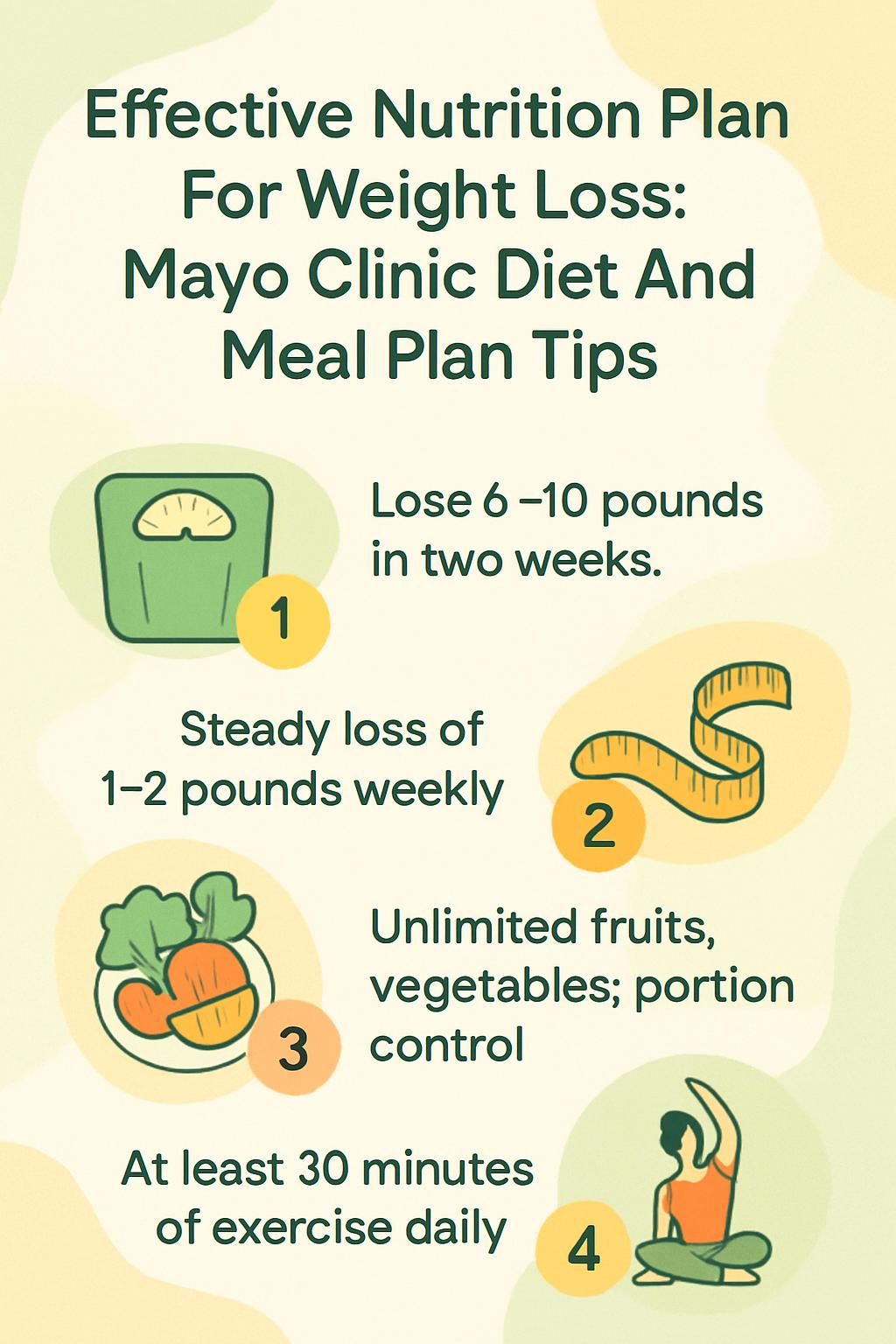Effective Nutrition Plan For Weight Loss: Mayo Clinic Diet And Meal Plan Tips
Our Nutrition Assistant AI Suite will transform your body. You will lose fat, get toned, and build muscle. Gain confidence and optimal health.
Healthy eating feels hard when you are losing weight and want to keep it off. The Mayo Clinic Diet gives you a clear nutrition plan for weight loss that favors smart food choices, more fruits and vegetables, and steady habits you can live with.
This guide explains how the program works, why experts rank it among the best diets for steady results, and how to build a simple meal plan that fits your daily calorie target.
Keep reading to see how this eating plan can fit real life and help you start losing weight safely.
Key Takeaways
- The Mayo Clinic Diet, created by medical experts and explained in books such as “The Mayo Clinic Diet” (Hensrud DD, 2017), uses behavior-change science to support successful weight loss.
- Two phases guide progress. Lose It! targets 6 to 10 pounds in two weeks, then Live It! aims for 1 to 2 pounds per week.
- Meals center on unlimited fruits and vegetables, whole grains, lean proteins like fish or beans, and healthy fats such as olive oil, with portions guided by the Healthy Weight Pyramid.
- Evidence shows these habits lower risks for heart disease and diabetes better than fad diets or very low-calorie plans.
- Physical activity, at least 30 minutes daily, plus food tracking help you maintain results. Talk with a healthcare provider first if you have chronic conditions.

Overview of the Mayo Clinic Diet

The Mayo Clinic Diet is built from research and clinical experience. It supports healthy weight management through simple food choices and habits that last.
What is the Mayo Clinic Diet?
Developed by Mayo Clinic professionals, this program helps you lose excess weight and improve health. You add helpful habits like eating more fruits and vegetables and cut back on habits that slow progress, such as extra sugar or high-fat snacks.
You do not have to count every calorie or remove entire food groups. Non-starchy vegetables and fruits are unlimited so your plate stays full while calories stay in check.
Daily meals follow the Healthy Weight Pyramid, a visual guide to portions for each food group. The plan promotes balanced eating, steady weight management, and lower risk for heart disease.
You build skills you can use for life instead of depending on quick fixes or very-low-calorie diets.
You do not need to count calories or cut food groups. Fill half your plate with produce at every meal.
How does it support long-term weight management?
The diet uses behavior-change tools to help you set realistic goals and handle setbacks. You learn to track eating, use a weight tracker, and plan meals with low-fat yogurt, whole grain bread, beans, and lean protein.
The Healthy Weight Pyramid makes portion planning simple. With support, you keep healthy portions, adjust calorie levels to your needs, and cook nutrient-rich recipes.
During Live It!, the long-term phase, you practice new routines for life. If plans change, you update goals without starting over. Many people find that grocery tips and simple cooking methods, like roasting instead of frying, keep the routine easy and effective.
Why Choose the Mayo Clinic Diet?
The Mayo Clinic Diet follows research-based guidance to help you lose weight in a safe, steady way. The eating style builds lasting habits that support long-term health and weight goals.
What expert research backs this diet?
Mayo Clinic experts shaped this approach using decades of nutrition research. Books such as “The Mayo Clinic Diet” (2nd ed., 2017) and “The Mayo Clinic Diabetes Diet” (2nd ed., 2018) share strategies based on current science.
The plan aligns with the 2020-2025 Dietary Guidelines for Americans. It promotes less saturated fat and more dietary fiber, which helps lower risks for heart disease, high blood pressure, diabetes, and other conditions.
Many healthcare providers use it as a program that supports sustainable lifestyle change and better health outcomes across different eating styles.
Evidence-based plans tend to beat fads in the long run, notes Dr. Donald Hensrud of Mayo Clinic.
Tracking your intake with a simple food journal often matches what studies recommend. It can help you pick better snacks and raise your daily vegetable servings.
How does it promote sustainable lifestyle changes?
You build helpful habits and drop unhelpful ones, which leads to change that lasts. The program avoids strict counting and bans on food groups. You choose foods using the Healthy Weight Pyramid, with fruits, vegetables, and whole grains at the base.
Digital tools such as food journals and weight trackers make goal setting and follow-through easier during your weight-loss journey.
Flexibility improves adherence. You can adapt the plan for vegetarian meals or medical needs like high cholesterol. For example, a veggie burger at lunch or oatmeal with fruit at breakfast fits well and still feels satisfying.
This way of eating fits daily life. That is why it outperforms quick fixes that fade fast.
How the Mayo Clinic Diet Works
The plan guides your eating with clear steps. It helps you lose weight safely while building habits you can keep.
What are the Lose It! and Live It! phases?
Lose It! is a two-week jumpstart. You focus on daily habits and aim to lose 6 to 10 pounds, about 2.7 to 4.5 kilograms. You add 5 helpful behaviors and break 5 unhelpful ones, like skipping dessert or swapping butter for olive oil when cooking.
You also test simple add-ons, such as an extra walk after lunch and water in place of sugary drinks.
Live It! follows and continues for life. You aim for 1 to 2 pounds per week until you meet your goal, then you maintain it with the same routines. Many people find that building salads as the base of meals helps manage portions and cut calories without losing flavor or variety.
How to develop lasting healthy habits?
Lasting habits grow from small, repeatable actions. Use these steps to stay consistent and motivated.
- Track intake daily with a food diary or app. Note carbohydrates, fats, and proteins so patterns are clear.
- Plan meals ahead. Center plates on whole grains like brown rice or quinoa and lean proteins such as fish or cottage cheese.
- Follow the Healthy Weight Pyramid. Make fruits and vegetables the base for more fiber and fewer calories.
- Practice portion control. Measure servings to avoid overeating calorie-dense foods like cheese, hamburger, or chocolate.
- Keep regular meal and snack times. Avoid eating while watching TV to limit mindless snacking.
- Move for 30 minutes daily, such as brisk walking, biking, or swimming, to support heart health and fat loss.
- Limit saturated and trans fats and creamy sauces. Choose plant fats from nuts and seeds instead.
- Drink water through the day. Trade sugar-sweetened drinks for water or herbal tea.
- Use behavior tools from the program to handle lapses, then restart with the next meal.
- Plan weekly menus with nutrient-dense meals, such as hummus with cucumber, baked sweet potato, salmon with couscous, or a sandwich loaded with leafy vegetables.
- Talk with a healthcare provider before starting if you have conditions like diabetes or atherosclerosis. Personal adjustments improve safety.
Key Components of the Mayo Clinic Diet
This program uses a science-based plan to promote healthy eating and long-term weight control. It gives you simple tools to make better food choices every day.
How to choose nutritious foods wisely?
Start with the base of the Healthy Weight Pyramid. Choose vegetables, fruits, whole grains, beans, and nuts like almonds and seeds. These foods are nutrient-rich and relatively low in calories.
Fill half your plate with produce at each meal. This supports fullness, steady blood sugar, and better digestion. Add beans or lentils for plant protein and fiber.
Eat fish more often than red meat to lower saturated fat and raise omega-3 fatty acids, a type of healthy fat that supports the heart. Pick low-fat dairy such as skim milk or fat-free yogurt to reduce calories while keeping calcium and protein.
Limit refined grains like white pasta and white flour. Swap in whole grain bread, brown rice, or whole wheat pasta. Use olive oil instead of mayonnaise or butter to support heart health without empty calories.
These choices help you build healthy meals without keeping a running calorie tally.
What is the Mayo Clinic Healthy Weight Pyramid?
The Healthy Weight Pyramid is a visual guide to portions. Fruits and vegetables sit at the base, so they should fill most of your meals. Sweets and other calorie-dense foods sit at the top, which signals that you should eat them only occasionally.
Portion control becomes easier when the pyramid shapes your plate. Many people notice they stay full longer when half the plate is produce, especially colorful vegetables and fruit.
The approach works with plant-based or Mediterranean eating styles as well. For simple serving tips that match your calorie needs, see www.mypyramid.gov.
How to master portion control?
Use the pyramid to guide how much to eat from each food group. Most of your plate should be produce. Fats like olive oil or nuts should be used in small amounts.
The plan includes 1,200, 1,400, 1,600, 1,800, and 2,000 calorie day options. Choose the level that matches your goals and activity.
Switch to fat-free or low-fat dairy and dressings to trim calories while keeping plate volume high. Serve meals on smaller dishes to make portions look and feel bigger.
Measuring cereal, pasta, and other easy-to-overeat foods can help you stay within your nutrition plan. Mastering portion size sets up the next step, which is building meals centered on fruits and vegetables.
Tips for Planning Weight Loss Meals
Planning ahead helps you make better food choices and manage calories. These tips support a diet that works for steady weight loss and better health.
How to add more fruits and vegetables?
Make produce the base of your meals to match the Healthy Weight Pyramid. You can enjoy unlimited servings in both phases of the Mayo Clinic Diet.
Add orange slices to oatmeal at breakfast. Include a big salad or vegetable soup with lunch and dinner. Snack on carrots, bell pepper strips, or apples instead of chips.
If you have diabetes, favor vegetables over fruit to better manage blood sugar. A quick rise in fiber may cause mild bloating at first. These symptoms usually fade after a few days as your body adjusts.
Eating more from the bottom of the pyramid improves nutrition, lowers calories, and supports weight loss according to Mayo Clinic experts.
How to include whole grains and lean proteins?
Use brown rice, whole wheat pasta, and oatmeal often. Swap white bread for 100 percent whole grain bread. Try quinoa in salads for extra fiber and a nutty taste. Many people feel fuller when they have at least three servings of whole grains per day.
Choose lean proteins at each meal. Good picks include roast chicken, turkey breast, fish, eggs, beans, and nuts. Limit red meats that are high in saturated fat. Beans bring plant nutrients and fiber to soups, bowls, and salads.
These foods raise satisfaction and help control calorie intake without added sugars or excess fat.
Why focus on healthy fats intake?
Healthy fats from nuts, olive oil, and fatty fish are part of the plan. They support heart health and may lower the risk of coronary artery disease.
Replacing saturated or trans fats with healthy fats can reduce cholesterol and support weight control. A Mediterranean diet pattern often includes salmon, walnuts, and extra-virgin olive oil.
These fats also have anti-inflammatory benefits. Omega-3 fats from fish can support blood vessel health after a heart attack, called myocardial infarction.
Simple swaps work well. Choose unsalted nuts or avocado slices for snacks instead of fried or processed options.
How to stay well-hydrated?
Pick water or low-calorie drinks instead of sugary beverages. Higher fiber from fruits, vegetables, and whole grains increases your need for fluids because fiber absorbs water in the gut.
Mayo Clinic guidance suggests sipping water throughout the day rather than waiting for thirst. A refillable bottle keeps hydration easy at work or during exercise.
Replacing soda with plain or flavored water trims calories and supports weight goals. Better hydration improves digestion and helps energy stay steady.
What Are Some Sample Daily Menus?
Sample menus help you start with confidence. Use these ideas to meet your calorie goals while keeping meals simple and balanced.
What are healthy breakfast ideas?
Overnight oats with berries and fresh pear make a filling breakfast that fits the Mayo Clinic Diet. A Mediterranean-style plate might include a hard-boiled egg, an orange, or whole grain toast with avocado and tomato.
The 1,200 calorie Mediterranean sample menu often features nonfat yogurt with sliced fruit, or oatmeal made with low-fat milk. These choices provide fiber, protein, and healthy fats so you stay satisfied until lunch.
Breakfast is flexible across calorie levels, from 1,200 to 2,000 calories. Planning ahead helps prevent skipped meals, which often leads to overeating later.
Combining fruit, eggs, and whole grains supports weight loss and builds habits you can keep through your Mayo Clinic Diet journey.
What are balanced lunch options?
Build lunches with lean protein, fiber, and healthy fats. Popular options include Tuscan white bean soup with a pesto drizzle or a grilled chicken salad with chickpeas and whole grain croutons.
These lunch ideas appear in 7-day and 30-day meal plans across different calorie levels and dietary needs.
Balanced macronutrients help manage hunger and steady blood sugar through the afternoon. Lean meats, beans, leafy greens, lentils, quinoa, berries, and low-fat dairy match expert guidance for satiety and nutrition.
What nutrient-rich dinners can you try?
Sheet-pan roast chicken with broccolini, onion, and tomatoes is simple and balanced. It delivers lean protein and plenty of vegetables in one pan and often lands near 450 calories.
Spicy jerk shrimp with pineapple is another sheet-pan idea. It is colorful, quick, and keeps saturated fat low.
These dinners provide fiber from vegetables and healthy fats from olive oil or fish. The Healthy Weight Pyramid suggests filling most of your plate with nutrient-dense foods to support your weight goals.
Lean proteins such as skinless chicken or seafood should take about one quarter of your plate. Whole grains like brown rice or quinoa add staying power without extra salt.
Choose meals like these most nights to build strong habits over time.
What snacks help manage hunger healthily?
Snacks can curb hunger between meals if you choose nutrient-dense options. Aim for produce first, for example a cup of bell pepper slices with a banana.
The program allows up to 75 calories per day from sweets. You can save those and spread them across the week if that works better.
For diabetes-friendly options, choose low-sugar fruit or raw vegetables. The Healthy Weight Pyramid favors plant foods for snacks over processed items high in saturated fat or sugar.
Planned snacks help keep energy steady and cut cravings for less healthy foods later.
How Important Is Physical Activity?
Daily movement makes weight loss easier and helps you keep the weight off. Think of exercise as the partner to your eating plan.
Why incorporate 30 minutes of exercise daily?
At least 30 minutes of activity each day supports weight loss on the Mayo Clinic Diet. Both Lose It! and Live It! include movement as a key part, not an extra step.
Research from Mayo Clinic links daily activity to better heart health, calorie burn, and improved mood. Regular exercise can lower harmful byproducts in the body, often called free radicals, and reduce chronic disease risk.
You do not need a gym. Brisk walking in your neighborhood counts. Short sessions are easier to schedule, which keeps motivation high and stress lower.
How to choose enjoyable physical activities?
Pick activities you like and can repeat. Walking, cycling, and resistance training build heart health and muscle strength.
Work movement into daily life. Take the stairs, park farther from the entrance, or do a short yoga session at home. Mayo Clinic experts encourage personalizing your routine so it feels rewarding.
Start small if you are new to exercise or have medical concerns. Aim for 30 minutes of moderate movement most days and adjust based on energy and ability.
Benefits of the Mayo Clinic Diet
This program helps you build better eating habits while working toward a healthy weight. The benefits stack up as your routines improve.
How does it encourage better eating habits?
You start by filling half your plate with fruits and vegetables. That simple rule supports positive behavior change and reflects the Healthy Weight Pyramid.
Shopping lists, meal prep tips, and portion guidance make it easier to stick to your plan. Digital tracking tools let you monitor food and activity. Consistent tracking often improves weight loss and habit formation.
Many people notice they begin to prefer whole foods over processed snacks after a few weeks. The program is flexible on daily calorie goals so you can meet targets without feeling boxed in.
How does it support healthy weight maintenance?
Once you settle into better choices, maintenance becomes easier. The LIVE IT! phase supports routines that prevent regain.
You can continue to lose about 1 to 2 pounds per week until you reach your goal, which helps avoid rebound weight. Food logs help you stay mindful and make small adjustments when needed.
Research shows long-term success comes from daily habits, not short-term restriction. That is why this plan, like DASH, works best when personalized to your calorie needs and lifestyle.
How does it reduce chronic disease risks?
The diet can lower risks for type 2 diabetes, heart disease, high blood pressure, and sleep apnea. You eat nutrient-dense foods rich in vitamins, minerals, fiber, and healthy fats while limiting empty calories.
Reducing saturated fat, sodium, and added sugars cuts key risk factors. Losing even 5 to 10 percent of body weight can lower blood sugar and cholesterol. The meal plan fits your calorie goals while focusing on whole grains, produce, and lean proteins.
These evidence-based steps support better health day after day.
What Are the Potential Risks?
New programs can pose challenges. These notes help you adapt the plan to your needs and avoid common issues.
Why consult a doctor before starting?
Medical guidance is important before starting any diet, especially if you have diabetes or other health issues. Your doctor can make sure the plan is safe with your medicines and conditions.
For example, people with diabetes may need to adjust fruit or total carbohydrates based on blood sugar levels.
Very low-calorie diets under 800 calories per day require medical supervision. Supervision lowers the risk of nutrient gaps or electrolyte problems.
Talking with a professional first can help you make changes safely and avoid complications.
How to address individual dietary needs?
Work with your doctor to review your nutrition needs before starting. People with diabetes may do better with more vegetables than fruit, and veggie-based snacks can aid blood sugar control.
Unlimited produce may raise fiber quickly, which can cause short-term digestive changes. These usually ease within days.
Natural sugars in fruit can raise blood sugar at first. This often improves as weight drops. With guidance, the plan can be adjusted for allergies or specific nutrition goals.
The Mediterranean diet encourages variety and can inspire menu ideas that still follow the Healthy Weight Pyramid and your calorie target.
Extra Meal Planning Tips
Better meal planning keeps you on track. These steps make your eating plan easier to follow on busy days.
How to organize meals in advance?
Use a 7-day or 30-day meal plan from trusted sources such as Mayo Clinic. Pick options that match your calorie goals and preferences, like high-protein, high-fiber, or vegetarian plans.
Planning supports portion control and reduces extra calories from last-minute choices. Map out breakfast, lunch, dinner, and snacks for the week. If you need blood sugar support or want to target belly fat, choose menus that fit those goals.
Write a detailed grocery list to avoid impulse buys. Wash and cut produce in advance for fast meals and snacks. Pre-portion grains like quinoa or brown rice into containers so Mediterranean-style meals come together quickly.
How can food trackers help monitor your diet?
Food trackers, including electronic journals from the Mayo Clinic Diet, make it simple to log what you eat and drink. Recording meals, snacks, and beverages in real time shows whether you are meeting daily goals for calories, protein, fats, and carbs.
Tracking builds motivation because small improvements are visible. Clear targets also make it easier to adjust without guessing.
If setbacks happen, your log reveals patterns early so you can correct course. Many people report progress within two weeks of consistent tracking because they spot easy wins each day.
Which foods should you avoid for weight loss?
Limit processed foods high in saturated fat, trans fat, sodium, and added sugar. Common examples include sugary drinks, commercial baked goods, fried snacks, and fast food.
One can of soda can deliver more than 35 grams of sugar. A small bag of chips can add over 150 milligrams of sodium.
Avoid mindless snacking while watching TV. Eating from large packages often leads to larger portions than planned. Staying aware of ingredients and serving sizes helps you choose better options in daily routines.
FAQs About the Mayo Clinic Diet
You may have questions about how to adapt the program to your health needs and preferences. These answers can help you get started with confidence.
Can the diet be customized for different needs?
Yes. You can pick meal plans that fit your calorie goals, health conditions like diabetes or heart health needs, and preferences such as vegetarian meals.
The guidelines are flexible, so you can swap ingredients and still stay on track. If you need gluten-free, anti-inflammatory, or budget-friendly vegan options, you can find plans that match.
Digital tools help you adjust foods based on taste or nutrition targets. People with allergies can select safe swaps and keep meals balanced.
Is it suitable for vegetarians or allergy sufferers?
Yes. Vegetarian and vegan plans feature plant proteins, whole grains, fruits, and vegetables. If you need gluten-free meals, options are available to match your needs.
The program is easy to adapt for common allergens. A registered dietitian can help you build safe, satisfying choices that still support weight loss.
Comparing the Mayo Clinic Diet with Other Diets
Seeing how this plan compares can help you choose an eating style you can keep. The best diet is the one you can follow.
How does it differ from the Mediterranean Diet?
The Mayo Clinic Diet allows unlimited fruits and vegetables. Some versions of the Mediterranean diet suggest moderate portions. The Mayo program adapts without cutting entire food groups. Stricter Mediterranean plans may limit sweets or red meats more firmly.
The Mayo Clinic approach gives more attention to behavior change and daily habits. Mediterranean plans often focus more on specific recipes and ingredients.
Many people feel fuller on the Mayo plan since it encourages as many vegetables as needed to manage hunger.
What are the differences with the DASH Diet?
Both plans emphasize vegetables, fruits, whole grains, and lean proteins. With the Mayo Clinic Diet, fruits and vegetables are unlimited. DASH uses strict portion control and more routine calorie counting.
The Mayo approach offers more flexible tools, such as behavior methods and digital tracking. DASH focuses mainly on reducing blood pressure through food choices.
Some users find DASH feels strict in social settings. The Mayo plan often fits daily routines more easily because it focuses on habits, not rigid rules.
Final Thoughts and Recommendations
You can shape this program to match your goals and preferences. The Mayo Clinic Diet offers proven steps and day-to-day guidance so change feels manageable.
How to adopt a balanced weight loss strategy?
Set your daily calorie target using science-based ranges. Many women do well at 1,200 to 1,500 calories. Men and very active women often need 1,500 to 1,800 calories. Reducing intake by 500 to 750 calories per day usually leads to about one pound of weight loss per week.
Build plates with fruits, vegetables, whole grains, lean proteins, and healthy fats in the right amounts. Choose low-fat or fat-free dairy and lighter dressings.
Schedule at least thirty minutes of activity most days. Walking works well if intense workouts are not your style. A simple meal tracker can reveal patterns and help you adjust faster.
Check with your healthcare provider before major changes, especially if you take medicines or manage a condition.
How to make the Mayo Clinic Diet a lifestyle choice?
After you adopt a balanced plan, focus on daily routines that stick. Use Mayo Clinic tools to keep meals simple, track progress, and refresh goals over time. The LIVE IT! phase builds skills that support long-term weight management.
Set small weekly goals, such as trying two new vegetables or logging meals five days in a row. Subscribing to official resources can keep you current as nutrition science evolves.
This steady approach can lower chronic disease risks and help you keep results, turning short-term wins into lasting habits.
Conclusion
Choosing the Mayo Clinic Diet gives you a clear meal plan that supports weight management and better health. You fill your plate with fruits, vegetables, and whole grains, then add lean proteins and healthy fats. The eating plan is flexible, so it fits your tastes, schedule, and daily calorie needs.
Doctors designed this program using evidence and behavior science. Regular meal planning, simple recipes, and daily physical activity help you build habits that last. You get better energy, fewer cravings, and lower health risks over time.
Start with one plate, one walk, and one smart swap today. Small steps add up, and this approach can help you keep losing weight while improving your well-being.
FAQs
1. How can the Mayo Clinic Diet help with weight loss?
The Mayo Clinic Diet focuses on healthy eating patterns and encourages gradual, sustainable weight loss. The program can be tailored to fit individual needs, making it easier for people to follow long term.
2. Can this nutrition plan be adjusted for different lifestyles or health conditions?
Yes, the program can be tailored based on personal preferences, activity levels, and medical requirements. This flexibility supports a wide range of individuals seeking effective meal plan tips.
3. What are some key features of an effective nutrition plan from the Mayo Clinic?
Key features include portion control, balanced meals with fruits and vegetables, whole grains, lean proteins, and limited added sugars or fats. The program can be tailored so users meet their specific goals while following evidence-based guidelines.
4. Is there scientific support for using the Mayo Clinic Diet as a weight loss strategy?
Research shows that structured programs like this one promote lasting results when combined with regular physical activity and behavioral changes. The diet’s focus on real foods aligns with recommendations from leading health organizations; credible sources highlight its effectiveness in clinical studies.
Summary: A well-designed nutrition plan such as the Mayo Clinic Diet offers structure along with flexibility since the program can be tailored to each person’s unique situation. Evidence supports its use for safe and steady weight loss through practical meal planning strategies backed by research data.







